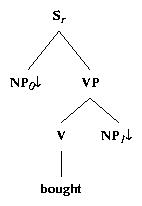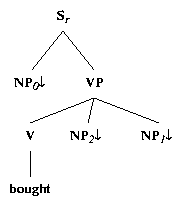

In sentence ((1)), the verb buy subcategorizes for a direct object NP. The elementary tree anchored by buy is shown in Figure 4.1(a) and includes nodes for the NP complement of buy and for the NP subject. In addition to this declarative tree structure, the tree family also contains the trees that would be related to each other transformationally in a movement based approach, i.e passivization, imperatives, wh-questions, relative clauses, and so forth. Each tree family selected by its anchor represents all the various syntactic environments that it can appear in. Sentence ((2)) shows that buy also subcategorizes for a double NP object. This means that buy also selects the double NP object subcategorization frame, or tree family, with its own set of transformationally related sentence structures. Figure 4.1(b) shows the declarative structure for this set of sentence structures.
 |
0.5in |  |
| (a) | 0.5in | (b) |
Entire classes of anchors select a tree family. All the transitive verbs form a class which selects the transitive tree family. Recall that a tree family is a group of trees related by some syntactic transformations. Since an entire class of anchors are selecting this tree family, the assumption is that these syntactic transformations are valid for each member of this class. For instance, wh- extraction is a syntactic transformation that will apply regardless of any idiosyncratic properties of any particular anchor of the tree family. Chapter 6 contains more information about the different tree families in the grammar. There are some syntactic transformations, however, that are sensitive to the properties of a particular anchor within the same subcategorization frame. The ergative (or transitive-inchoative) alternation for transitive verbs is one such transformation. Only a subset of the transitive verbs can undergo this transformation. A more rigorous definition of tree family that accounts for such lexical idiosyncrasies within an otherwise homogeneous family is discussed in detail in Appendix B.